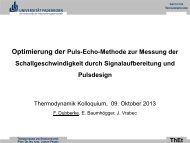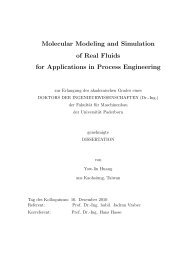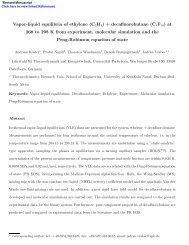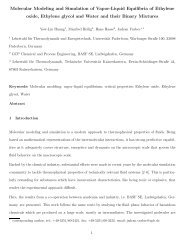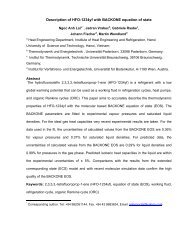ms2: A Molecular Simulation Tool for Thermodynamic Properties
ms2: A Molecular Simulation Tool for Thermodynamic Properties
ms2: A Molecular Simulation Tool for Thermodynamic Properties
You also want an ePaper? Increase the reach of your titles
YUMPU automatically turns print PDFs into web optimized ePapers that Google loves.
memory scales linearly with the number of processors that are used. For most applications of <strong>ms2</strong> a total RAM<br />
of 2 GB is sufficient.<br />
6.5. Comparison to other codes<br />
Monte-Carlo. The per<strong>for</strong>mance of<strong>ms2</strong> was evaluated against the simulation programMCCCS TowheeV6.2.7<br />
[67], which is widely in use and well accepted by the scientific thermodynamic community. In a first step,<br />
the comparison was restricted to a simple NVT simulation of the test case. <strong>ms2</strong> and MCCCS Towhee,<br />
both compiled with the Intel i<strong>for</strong>tran compiler, executed the MC test case sequentially, i.e. with one process<br />
only, on a ”Nehalem”/Infiniband cluster with an equal number of MC moves. A sequential run was executed<br />
since MCCCS Towhee is not yet prepared <strong>for</strong> parallelization. The per<strong>for</strong>mance of <strong>ms2</strong> was faster than the<br />
MCCCS Towhee program <strong>for</strong> this simulation by a factor of around 20.<br />
An important application of <strong>ms2</strong> is the determination of VLE data. The present comparison was restricted to<br />
two other programs: MCCCS Towhee [67] and theErrington Gibbs ensemble Monte-Carlo code [68]. Both<br />
codes use the Gibbs ensemble approach <strong>for</strong> the determination of VLE data, a simulation scenario that is not yet<br />
supported by<strong>ms2</strong>. Instead, the grand equilibrium method was used in<strong>ms2</strong> <strong>for</strong> determining the VLE.<br />
The test case was again a mixture of methanol and ethanol at T = 393 K, using Nl = 1372 molecules <strong>for</strong> the<br />
liquid phase andNv = 500 molecules <strong>for</strong> the gas phase. These numbers were also used as starting values <strong>for</strong> the<br />
Gibbs ensemble calculations. For MCCCS Towhee and the Errington Code, three different types of moves<br />
were allowed, translational and rotational displacement, volume exchange and molecule transition between the<br />
two simulation volumes. The moves were chosen with probabilities of 79%, 1% and 20% respectively, which<br />
are typical numbers <strong>for</strong> simulations including dense liquid phases. In <strong>ms2</strong>, the number of moves was restricted<br />
to two in the liquid phase, translational and rotational displacements (Nl times) and one volume fluctuation each<br />
loop. For the gas phase simulation, a move <strong>for</strong> insertion and deletion of molecules was additionally invoked<br />
twice in each loop. The overall execution time was set to 96 hours execution time, which is about the maximal<br />
time that is currently provided <strong>for</strong> a single simulation in high per<strong>for</strong>mance computing centers. The runs were<br />
per<strong>for</strong>med sequentially, sinceMCCCS Towhee and theErrington code are not suited <strong>for</strong> parallel execution.<br />
For this test case, <strong>ms2</strong> showed the best per<strong>for</strong>mance. Within the 96 h, <strong>ms2</strong> calculated 52000 loops in the liquid<br />
phase simulation, and 50000 loops in the vapor phase simulation. The Errington code per<strong>for</strong>med second best<br />
in this test, running 22000 loops, followed by Towhee, which ran 6000 loops.<br />
The per<strong>for</strong>mance of the codes influenced the quality of the simulation results drastically. For the VLE test case,<br />
the reference phase equilibrium data taken from the literature comprise a vapor pressure of0.58 MPa, a saturated<br />
liquid density of 17.22 mol/l and a saturated vapor density of 0.19 mol/l. <strong>ms2</strong> reproduced the experimental<br />
results well in the given time. The calculated vapor pressure of <strong>ms2</strong> was 0.53 MPa, while the saturated liquid<br />
density of the mixture was predicted to be17.54 mol/l and the saturated vapor density to be0.18 mol/l. The sta-<br />
tistical uncertainties <strong>for</strong> the quantities was acceptably low, being0.01 MPa <strong>for</strong> the vapor pressure and0.03 mol/l<br />
and 0.003 mol/l <strong>for</strong> the saturated liquid density and saturated vapor density, respectively. The Errington code<br />
calculated in the given time a vapor pressure of 0.19 MPa well as a saturated liquid density of 19.93 mol/l and<br />
23



